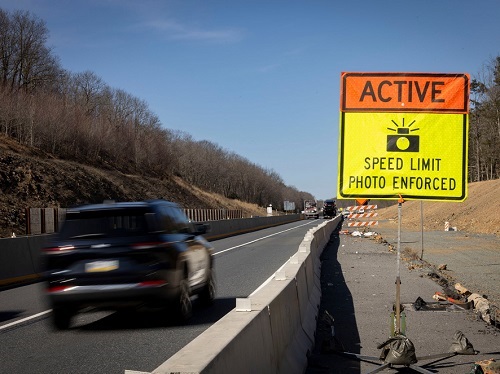The Pennsylvania Department of Transportation, the Pennsylvania Turnpike Commission, and the Pennsylvania State Police recently launched a statewide Work Zone Speed Safety Camera program that uses vehicle-mounted systems to detect and record motorists exceeding posted work zone speed limits by 11 miles per hour or more using electronic speed timing devices.
[Above photo by PennDOT]
The agency said motorists ticketed by the camera systems – which are only operational in active highway work zones where workers are present – will receive a warning letter for a first offense, a violation notice with a $75 fine for a second offense, and a violation notice with a $150 fine for third and all subsequent offenses. These violations are civil penalties only; no points will be assessed to driver’s licenses, PennDOT stressed.
The program is based on a five-year long Automated Work Zone Speed Enforcement pilot program, which recorded a 38 percent reduction in speeding in work zones (one mile per hour or more over the speed limit), a 47 percent reduction in excessive speeding in work zones (11 mph or more over the speed limit), and an up to 50 percent reduction in work zone crashes with the presence of a speed enforcement. PennDOT noted that pilot program became permanent when Governor Josh Shapiro (D) signed House Bill 1284 into law in December 2023.

“The Work Zone Speed Safety Camera program is about making work zones safer for both workers and motorists by reducing speeds and changing driver behavior,” said PennDOT Secretary Mike Carroll in a statement. “Data from the pilot program shows it was successful, and we’re pleased that it’s now a permanent program in Pennsylvania.”
“Speed safety cameras are important tools for discouraging drivers from exceeding posted speeds,” added PA Turnpike Chief Operating Officer Craig Shuey. “Paying attention and reducing speed are critical as drivers approach a work zone where workers are inches from live traffic. The goal of this program is to build awareness and most importantly, to change unsafe driving behaviors.”
“Many injuries and fatalities in work zones can be prevented if drivers simply slow down, and that’s the goal of this program,” noted Major Robert Krol, director of the Bureau of Patrol for the Pennsylvania State Police. “The cameras have been effective in making our work zones safer, and we look forward to seeing additional results from the program’s full-time implementation.”
In 2022, PennDOT noted that there were 1,293 work zone crashes in Pennsylvania, resulting in 14 fatalities, and 42 percent of work zone crashes resulted in fatalities and/or injuries. Since 1970, PennDOT has lost 90 workers in the line of duty. The PA Turnpike has lost 45 workers since 1945.
State departments of transportation in other parts of the country are also experimenting with camera systems to improve highway work zone safety.
For example, a law passed in 2023 now allows Arkansas law enforcement officers to use automated speed enforcement cameras in highway work zones statewide, with the help of the Arkansas Department of Transportation.

Passed by the Arkansas legislature and signed by Governor Sarah Sanders (R) in April 2023, this state law allows for the use of automated speed enforcement devices to capture images of speeding vehicles in highway work zones.
Information regarding the speeding vehicle will be transmitted to an officer stationed downstream, who will then have the authority to issue a warning or citation.
Meanwhile, as part of the state’s 2023 National Work Zone Awareness Week campaign, the New York Department of Transportation and New York State Thruway Authority jointly launched an “Automated Work Zone Speed Monitoring” pilot program that aims to slow down motorists traversing highway work zones.
That pilot program involved a total of 30 speed violation monitoring systems that rely on radar technology positioned in active work zones along New York State highways, with 20 of them located on NYSDOT-maintained roads and the remaining 10 on New York State Thruway-managed roads.
 States
States
INDOT Celebrates New I-70 Welcome Center Opening
November 21, 2025 States
States

